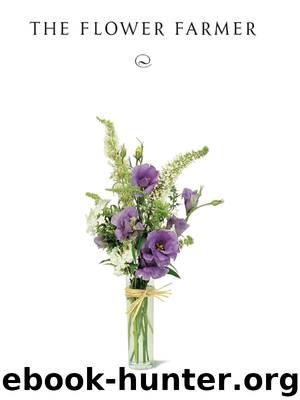The Flower Farmer by Lynn Byczynski

Author:Lynn Byczynski [Byczynski, Lynn]
Language: eng
Format: epub
ISBN: 9781603580762
Publisher: Chelsea Green Publishing
Published: 2008-03-30T21:00:00+00:00
Hydrangea paniculata ‘Limelight’
Hydrangea arborescens ‘Annabelle’.
• H. paniculata is a hardy species that flowers on new wood, so it is not affected by cold winters or late frosts. The old standby in the species, dating back to 1867, is ‘Grandiflora’, commonly known as peegee (the initials of paniculata ‘Grandiflora’). Many nurseries refer to all paniculatas as peegee hydrangeas. The flowers are large, cone-shaped clusters of sterile white flowers that turn pink as they age. A recent introduction that has been warmly received in the cut-flower world is ‘Limelight’, a green-flowered cultivar that is currently popular with designers. There are many other cultivars with flowers of white or pink.
• H. arborescens is another hardy species with round white flowers, which age to green. The most common cultivar is ‘Annabelle’, with flower heads up to 10 inches across. To get the largest flowers, prune them to the ground in late winter; if you want smaller flowers, prune sparingly, leaving 18 to 24 inches of old stems on the plant.
All types of hydrangeas are susceptible to wilting after they are cut because the stems have a hard time taking up water. The current recommendation is to cut them in the morning, when half the flowers in the inflorescence are open. Dip them in Quick Dip—a Floralife product into which you dip the stems for literally one second—then place the stems in buckets of hydration solution. Organic growers who can’t use these products can try dipping the stems into boiling vinegar and storing them overnight in deep, cold water.
STAR VALLEY FLOWERS Soldiers Grove, Wisconsin
www.starvalleyflowers.com
John Zehrer, the son of a Minnesota dairy farmer, bought a farm in southwestern Wisconsin in 1982 and began milking Jerseys. He realized, however, that the economics of the dairy business made for an uncertain future in farming.
So John started looking around for high-value crops to provide additional farm income. He had heard about a rising demand for curly willow, a twisted branch that is used in floral designs, and he thought it might grow well in his climate. He planted a few beds of curly willow beside his house, where it began to grow like a weed.
John realized that woody ornamentals might be the perfect crop for his hilly farm. He started investigating the other types of woodies used in the floral trade and found a half dozen commonly used types. His research gradually turned up more and more woody plants that weren’t widely available to florists but had good potential as cut branches. The beds of new plants fanned across one hillside, then jumped to a second field, and then a third. When the 80-acre farm filled up, he purchased an adjacent 160 acres.
Today, John’s business, Star Valley Flowers, has 165 acres of woodies that are shipped year-round to floral wholesalers and high-end florists around the country. Among the plants he grows are red osier dogwood, lilac, pussy willow, ninebark (Physocarpus opulifolius), snowberry (Symphoricarpos spp.), cranberry viburnum, spirea, euonymus, and hydrangea. And bittersweet. With 40 acres of bittersweet in production,
Download
This site does not store any files on its server. We only index and link to content provided by other sites. Please contact the content providers to delete copyright contents if any and email us, we'll remove relevant links or contents immediately.
Turbulence by E. J. Noyes(7942)
The Thirst by Nesbo Jo(6832)
Gerald's Game by Stephen King(4584)
Be in a Treehouse by Pete Nelson(3954)
Marijuana Grower's Handbook by Ed Rosenthal(3623)
The Sprouting Book by Ann Wigmore(3546)
The Red Files by Lee Winter(3368)
The Remains of the Day by Kazuo Ishiguro(3296)
Sharp Objects: A Novel by Gillian Flynn(2958)
Christian (The Protectors Book 1) by L. Ann Marie(2656)
Organic Mushroom Farming and Mycoremediation by Tradd Cotter(2631)
The Culinary Herbal by Susan Belsinger(2433)
Stone Building by Kevin Gardner(2353)
The Starter Garden Handbook by Alice Mary Alvrez(2285)
Lilac Girls by Martha Hall Kelly(2258)
The Unlikely Pilgrimage of Harold Fry by Rachel Joyce(2222)
The Lean Farm Guide to Growing Vegetables: More In-Depth Lean Techniques for Efficient Organic Production by Ben Hartman(2099)
Urban Farming by Thomas Fox(2063)
Backyard Woodland by Josh VanBrakle(1895)
